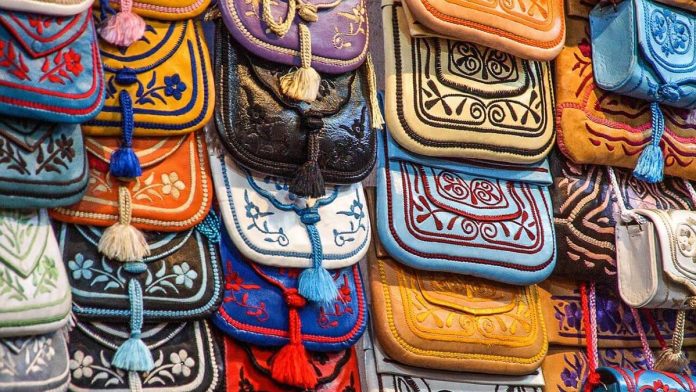When you travel to Morocco, it is almost impossible to leave it without surprising your family and friends by unforgettable souvenirs. From Moroccan carpets to Leather jackets and Berber jewelry; here is a full guide for shopping and what to buy in Morocco.
Shopping in Morocco
Souks “Market” in Morocco
The souks of Morocco are one of the country’s greatest attractions. Exploring these labyrinths of narrow streets and alleyways lined with exotic goods can make you feel like a character out of The Arabian Nights. Every town and village in Morocco has its souk for shopping, no matter how small: cities such as Fez and Marrakech have entire districts crammed with souks, each one dedicated to a particular trade, while country villages have a weekly general market. Some of the more interesting weekly souks where you can find what to buy in Morocco, like handicraft goods and souvenirs, are listed below:
Agadir (Sunday), Ifrane (Sunday), Moulay Idriss (Saturday), Ouarzazate (Sunday), Tafraoute (Wednesday), Taroudannt (Thursday & Sunday), Tinghir (Monday), Zagora (Wednesday & Sunday).
Must Read: 10 Best Places To Visit in Morocco in 2021
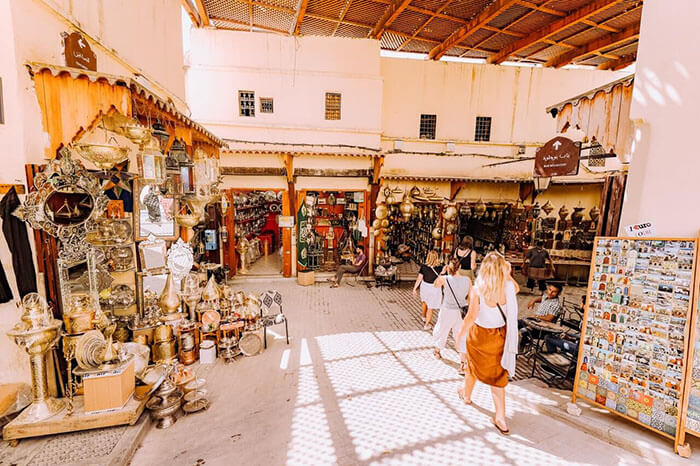
Bargaining in Morocco
In an economy where many products are handmade, each item has a different value depending on the quality of the workmanship. Thus, bargaining is a way of determining the proper price, and not simply a way for a shopkeeper to obtain more money from one customer than from the next. To secure the best price for your shopping in Morocco; however, you must get to know the market by browsing in several shops and asking the prices of comparable pieces.
Efficacious Negotiation Tactics
When you find what you want to buy in Morocco, ask the shopkeeper how much it costs, and then offer around half of what you’re prepared to pay. The owner will feign amazement at such an insultingly low price and discourse at length on the quality of the workmanship, but will eventually suggest a lower price. You, of course, will plead poverty and suggest that you can obtain the same thing more cheaply elsewhere, but end up making an offer slightly higher than your first. Ideally, you should have a partner who feigns impatience and tries to get you to leave. This good-natured banter will continue back and forth until you settle on a mutually acceptable price. If the item is expensive, say a carpet, a leather jacket, or a silver teapot, the process might involve several glasses of mint tea and a good half-hour of your time.
Must Read: Markets of Marrakech | Exploring the Vibrant Souks and Bazaars
The main rules of bargaining in Morocco
Two golden rules for your shopping in Morocco are:
Never to begin bargaining for something you do not genuinely intend to buy, and never to offer a price that you are not prepared to pay.
If you prefer not to bargain, visit the local Ensemble Artisanal, a state-run crafts shop that has fixed prices (ask at the tourist office for the nearest one). Here you can gain some idea of the range of crafts available and the prices you can expect to pay. (The variety will be greater and the prices a little lower in the souks.)
“Bargaining for carpets is thirsty work – glasses of mint tea ease the proceedings.
What to buy in Morocco
How to buy carpets and rugs in morocco
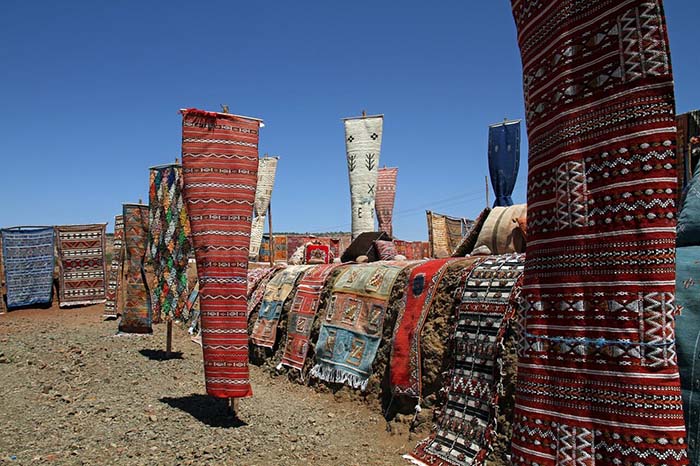
Moroccan rugs and carpets generally have a deeper pile and a looser weave of larger knots than the more familiar Persian or Turkish ones. The finest and most expensive are those from Rabat, Marrakech, and Meknès are also good places to buy. Also very attractive are the small woven rugs called killims, which are made mostly in the villages of the Middle Atlas Mountain; the carpet souk in Azrou comes highly recommended.
Jewelry
Chunky Berberi jewelry made of silver, amber, and semi-precious stones is strikingly beautiful and can be found at a fraction of the price you would pay back home. Good places to hunt out a bargain are Taroudannt and Tiznit, as well as Essaouira.
Leather:
The top of most visitors’ lists is Moroccan leather. The ultra-soft, fine-grained leather known as morocco is made from goatskins and is used for book bindings, desk sets, portfolios, wallets, purses, gloves, and many other articles.
Leather jackets, suitcases, satchels, and handbags are also popular. High-fashion leather clothing can be made to order in Agadir. Another favorite what to buy in Morocco is a pair of traditional Moroccan leather slippers, or babouches, yellow for men, and red for women.
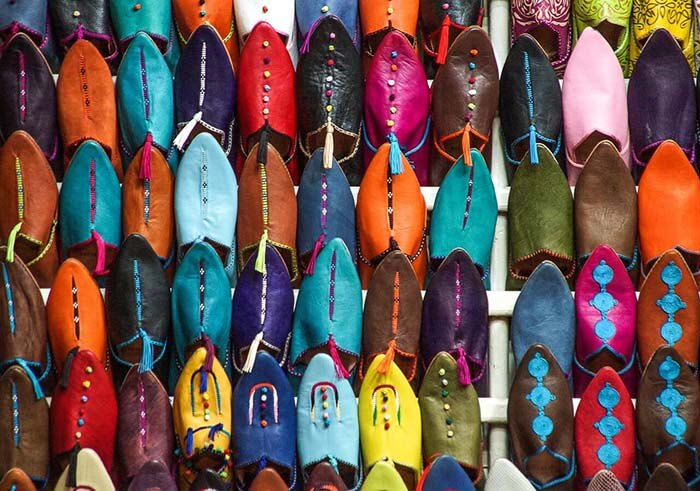
Metalwork:
In your shopping in Morocco, Probably you might like to buy a copper or brass tray with fine, ornate hammered designs which, along with a small folding wooden stand; make a useful and attractive little table. The squat, narrow-spouted teapots used for making mint tea can be made of both silver and pewter or even aluminum, so you can choose one that fits your budget.
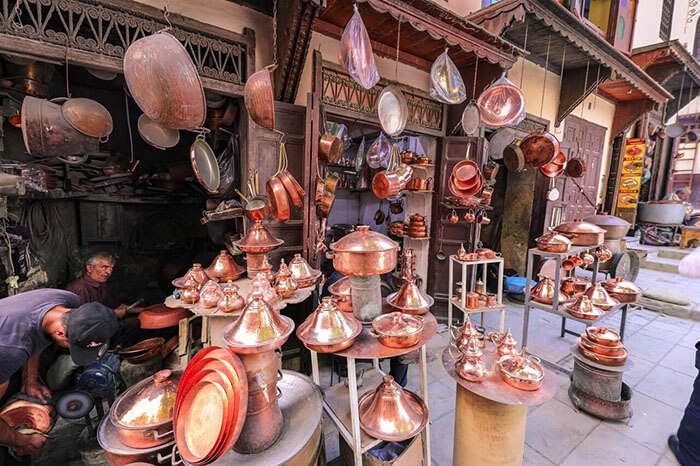
Read more: Where is Morocco located?
Pottery:
Fès, Meknès, Salé, Safi, and Marrakech are the best places to look for good-quality pottery. The classic souvenir is a conical couscous dish, but the choice of articles available is wide. Ranges from modern plates and coffee services to beautiful antique bowls and vases. Pottery is a number 1 of what to buy in Morocco.
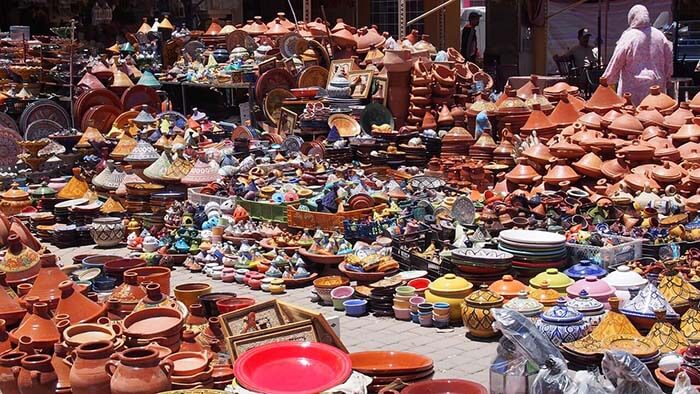
“Meknès craftsmen produce some of Morocco’s finest pottery and ceramics.”
Spices and Herbs:
Keen cooks will be unable to resist the heaps of fresh herbs and spices on offer in the souks. Saffron in particular is cheap by Western standards, and don’t forget to ask for the ‘shopkeeper’s choice’, called ras el hanout, an intriguing blend of 13 herbs and spices.
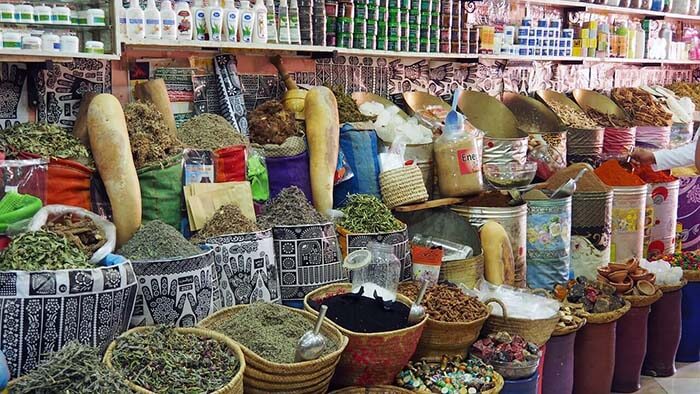
Woodwork:
Jars, boxes, chairs, and tables made from sweet-smelling cedarwood can be found in the Medinas of most major cities. In Essaouira, the specialty is carved and inlaid sandalwood, or thuya, which is made into chessboards, inlaid tables, backgammon sets, and polished jewelry boxes. Buy them from the craftsmen.
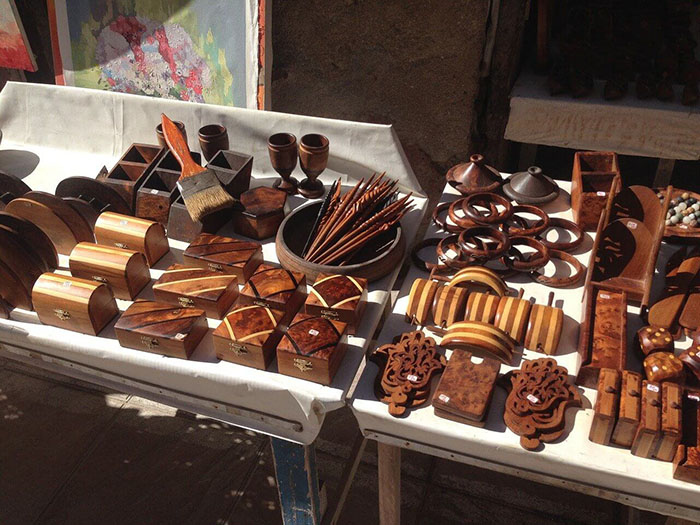
I hope you will enjoy a good experience time shopping in Morocco.
You need more information or suggestion about shopping in Morocco and what to buy in Morocco? Do you want more tips for your travel to Morocco? Please feel free to drop me a message in the comments below!

